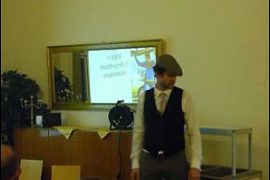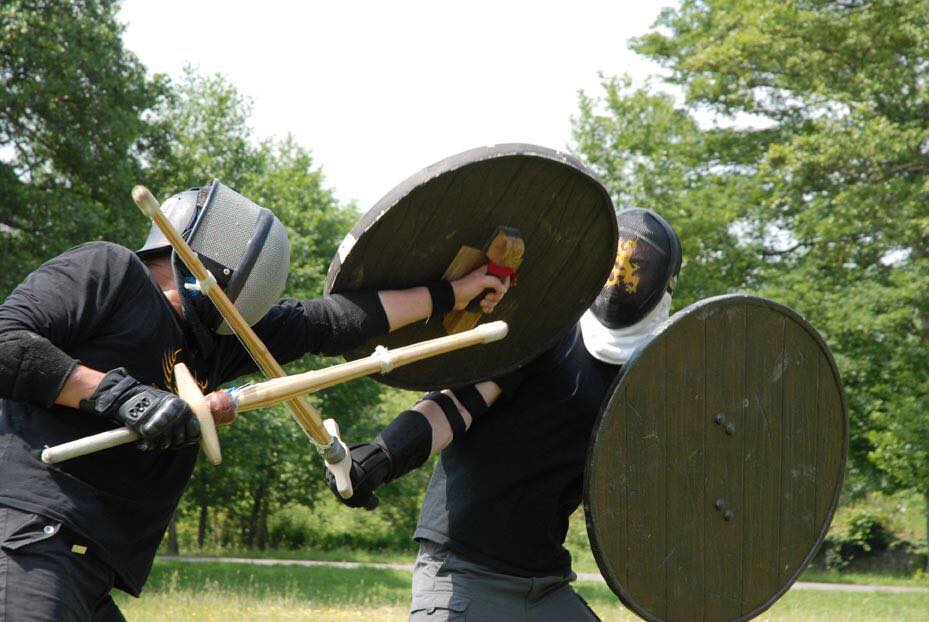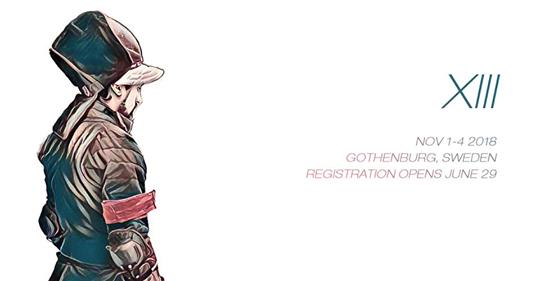
“Few men are born brave; many become so through care and force of discipline.”
Flavius Vegetius Renatus
Many pages have been written on medieval and renaissance combat treatises; every year, new translations, books, essays and blogs are added to the bibliography of weapons and combat during the Medieval Ages and the Renaissance. However, the subject of how knights and period fencers trained, especially as related to physical conditioning and strength, remains nearly unexplored.
There is a mildly generalised understanding that these groups trained their bodies by swinging heavy weapons, moving large and heavy objects and throwing stones. Still, many misconceptions around this subject remain. That is why I will present the advice given by the old combat masters and some statements made in period documents. I will briefly analyse some period illustrations, looking for a better understanding of how these men prepared for combat.
The classical influence on Medieval thought
One of the most influential texts during the middle ages and the renaissance, relating to combat and military training, was Epitoma Rei Militaris, written by the Roman Flavius Vegetius. In the first book of four, that form his work, Vegetius lists several activities for recruits to do. These activities can be split into four categories: physical labour, hand-to-hand combat, ranged combat and horseback combat.
Regarding physical combat, he states that recruits should be capable to march near 25 km in five hours. They should also run and jump (more likely avoiding obstacles) regularly. During the summer months, he also recommends swimming when possible. And he indicates that it was customary to have three sessions a month when recruits should march around 12 km carrying close to 20 kg. Finally, Vegetius recommends that all men at arms are accustomed to physical labour, such as chopping wood, carrying weight or crossing ditches.
Referring to hand-to-hand combat, he observes several times the importance to train the recruits on the armatura, which is the use of the weapons. They should practice hitting a pole with wooden weapons, weighing about twice as much as the real ones. Vegetius also affirms that recruits should be trained twice a day in this fashion; once in the morning and then again in the afternoon after their meal. Meanwhile, the veterans should do it once a day in a non-stop fashion.
He also considers it crucial that the recruits acquire horsemanship skills. He advises that during the winter months – when it was not possible to ride outside – wooden horses should be used to train mounting and dismounting techniques indoors. He constantly emphasises the importance of training the recruits with the bow and arrow, the throw of javelin, and the use of the sling.
The words of the combat masters
Vegetius’s adviceto keep the troops in good physical shape was maintained almost unaltered throughout the middle ages. Running, swimming, jumping, fencing, wrestling, riding and what later would be named vaulting were still kept in great esteem.
In his mid-1400’s work (most likely dedicated to Luithold von Königsegg), the well-known fencing master Hans Talhoffer, recommends his student to train twice a day. Much like Vegetius, he says to train once in the morning and then in the afternoon: “practice for two hours with effort, do not eat much fat, practice again in the afternoon for two hours”. Also, he encourages his student to:
“Strive after integrity
апd take great pains
in your knightly practices:
throwing апd pushing stones,
dancing апd jumping,
fencing апd wrestling,
running at the lance апd tournaments,
апd courting beautiful women.”
Notice how Talhoffer refers to knightly practices, including throwing and pushing stones, an activity often encouraged in period works, as well as in a significant amount of iconographical representations. This practice is referred to as steintossen in the Germanic territories, and it remains one of the Swiss national sports. It is also similar to Vegetius’s advice to accustom men to deal with heavy objects.
We can also see that he includes jumping, once more possibly referring to jumping over obstacles, which would be needed to avoid difficulties on the battlefield. He also includes dancing, something that some other authors around the time also recommend. Despite not mentioning it explicitly, the addition of horseback combat in his treatise, reaffirms the necessity to master the equitation.
On a similar note, Portuguese king Duarte I dedicates a segment in his work Livro dos conselhos, to physical training. It’s called Regimento para aprender alguas cousas armas, and in it we find yet another reference to long marches while carrying weight: “On the third hour on some days he goes to practice. And to practice he should arm himself with all weapons and go on foot a great distance up a [hill] for a long length, to strengthen himself”, and another recommendation to use heavier weapons to train “And when wishing to test with a particular weapon he does so with a heavier weapon which is something more than those seeking to carry on the day of combat”.
By the end of the 16 Century, the Italian master Giacomo di Grassi includes a brief section on physical training and body strengthening by the end of his work, where he makes some fascinating claims. In the first place he mentions that, indeed, those who shall fight had, or should have had, a specialised training regime. Their strength, thus, was not exclusively a result of daily labour, as commonly thought:
“You shall see gentleman, knights, and others to be most strong and nimble in running or leaping, or in vaulting, or in turning on horseback, and yet are not able by a great deal to bear so great a burden as a Country man or porter: But in contrary in running and leaping, the porter and Country-man are most slow and heavy, neither know how to vault upon their horse without a ladder. And this proceeds of no other cause, than for that every man is not exercised in that which is most esteemed.”
Notice that this specialised training, written a century after Talhoffer’s work, and eleven centuries after Vegetius, still recommends running, jumping and vaulting. Di Grassi also mentions the use of heavy weapons to strengthen the arms. Actually, it seems to be his favourite method, although, he opposes the traditional way of starting with the heavier weapon. Instead, he recommends to start with the real weapon or a lighter one, and increase the weight from there:
I commend not their opinion any way, who will for the strengthening of a man’s arm that he handle first a heavy weapon, because being first used to them, afterwards, ordinary weapons will seem the lighter unto him, but I think rather the contrary, to wit, that first to the end, he does not over burden and choke his strength, he handle a very light sword, and such a one, that he may most nimbly move. For the end of this art is not to lift up or bear great burdens, but to move swiftly.
But yet after he has sometime travailed with a light weapon, then it is necessary according as he feels himself to increase in strength of arm, that he take another in hand, that is something heavier, and such a one as will put him to a little more pain, but yet not so much, that his swiftness in motion be hindered thereby. And as his strength increases, to increase likewise the weight by little and little. So it will not be long, but that he shall be able to manage very nimbly any heavy sword.
Additionally, Di Grassi highlights the importance of finding a balance in the bodily strength, meaning that a man should be strong enough to move anything, but not so big that he becomes sloppy:
“Let a man be never so strong and lusty, yet he shall deliver a blow more slow and with less force than another shall who is less strong, but more exercised: and without a doubt he shall so weary his arms, hands and body, that he cannot long endure to labor in any such business… such weariness is vanquished by exercise… but that the body feet and arms are so strengthened, that heavy things seem light, and that they are able to handle very nimbly any kind of weapon, and in brief overcome all kind of difficulty and hardness.
What about other period sources?
The hausbuch Wolfegg, a late XV Century manuscript that illustrates daily life in the south German region, presents several illustrations of a knight’s routine. In the housebuch it’s mentioned to include “courting beautiful women” just as in Talhoffer’s introduction to MS XIX.17-3. It also notices the importance of jousting, tournaments and hunting. However, the most relevant illustration for this paper is the one denominated “Sol”, since it shows several men training. Two of them fight with staves, two more wrestle with federschwerts at their feet, while another pair exercises; one lifting stones, the other one throwing them.
Another example comes from Konungs skuggsjá, or “King’s Mirror”, a text written during the mid 13 Century, dedicated to the future King Magnus VI of Norway. The book includes advice given to the young prince about how a king shall handle different social, political and moral matters. In the section The Duties, Activities, and Amusements of the Royal Guardsmen, the prince asks his father to “point out the manners and customs which you think would be becoming to me, if I were employed in the royal service” within the long answer provided by the father several activities worthy of the king’s men, and how he should train, are listed, once more; both vaulting and horse riding are among the recommendations:
“…you should prefer the forms of amusement which I shall now point out to you. If you are sojourning where horses may be ridden and you have your own horse, put on heavy armor and, mounting your horse, train yourself in the art of sitting on horseback in the firmest and most handsome manner. Train yourself to press the foot firmly into the stirrup; keep your leg stiff and the heel a little lower than the toes, except when you have to guard against thrusts from the front; and practice sitting firmly with the thighs pressed close. Cover your breast and limbs carefully with a curved shield. Train your left hand to grasp firmly the bridle and the grip of the shield, and your right hand to direct the spear-thrust so that all your bodily strength will support it. Train your good steed to veer about when in full gallop; keep him clean and in good condition; keep him shod firmly and well, and provide him with a strong and handsome harness.”
When it is not possible to ride a horse, the father advises (just like King Duarte) to look for a partner to drill with the sword, shield and buckler in full armour. He also states that it is better to do so twice a day:
“But if you are in a borough or some such place where horses cannot be used for recreation, you should take up this form of amusement: go to your chambers and put on heavy armour; next look up some fellow henchman (he may be a native or an alien) who likes to drill with you and whom you know to be well-trained to fight behind a shield or a buckler. Always bring heavy armour to this exercise, either chain-mail or a thick gambeson, and carry a heavy sword and a weighty shield or buckler in your hand. In this game, you should strive to learn suitable thrusts and such counterstrokes as are good, necessary, and convenient. Learn precisely how to cover yourself with the shield so that you may be able to guard well when you have to deal with a foe. If you feel that it is important to be well trained in these activities, go through the exercise twice a day, if it is convenient; but let no day pass, except holidays, without practising this drill at least once; for it is counted proper for all king’s men to master this art and, moreover, it must be mastered if it is to be of service.”
The father’s final advice on training and worthy pastimes for a king’s man refers to lance throwing, heavier than those to be used on the battlefield, archery, and sling, as Vegetius said before. But he also says to acquire the ability to handle weapons with both hands, calling those with such skill as the most perfect and dangerous:
If you should like to try a variety of drills and pastimes, there are certain sports that one can take up out of doors, if that is thought more diverting. For one thing, you may have a pole prepared, somewhat heavier than a spear shaft, and put up a mark some distance away for a target; with these, you can determine how far and how accurately you can throw a spear and do it effectively. It is also counted rare sport and pastime to take one’s bow and go with other men to practice archery. Another pleasant and useful diversion is to practice throwing with a sling both for distance and for accuracy, and with a staff sling as well as with a hand sling, and to practice throwing stone missiles. Formerly the custom was for all who wished to become expert in such arts and thoroughly proficient in war and chivalry to train both hands alike to the use of weapons. Strive after the same skill, if you find yourself gifted for it, inasmuch as those who are trained in that way are the most perfect in these activities and the most dangerous to their enemies.
The paper “Using the “F” Word – The Role of Fitness in Historical Fencing” presents a series of testimonies and evidence of the training followed by the knightly classes, and by the common ones during the middle ages and the Renaissance, among them is particularly interesting what Jean Le Maingre, also known as Boucicaut, who lived by the end of the XIV Century, a contemporary to Duarte I of Portugal, and who was a famous French knight, stated about a squire training:
“Now cased in armour, he would practise leaping on to the back of a horse; anon, to accustom himself to become long-winded and enduring, he would walk and run long distances on foot, or he would practice striking numerous and forcible blows with a battle-axe or mallet. In order to accustom himself to the weight of his armour, he would turn somersaults whilst clad in a complete suit of mail, with the exception of his helmet, or would dance vigorously in a shirt of steel; he would place one hand on the saddle-bow of a tall charger, and the other on his neck, and vault over him…He would climb up between two perpendicular walls that stood four or five feet asunder by the mere pressure of his arms and legs, and would thus reach the top, even if it were as high as a tower, without resting either in the ascent or descent…When he was at home, he would practice with the other young esquires at lance-throwing and other warlike exercises, and this continually.”
Further than attesting again the common practice of vaulting, javelin throwing, and training with heavy weapons, I found remarkable his mention of dancing, coincident with Talhoffer’s advice to his student Luithold von Königsegg, a couple of decades later, and that evocates some period, and more modern, dances such as those executed by the Scottish highland regiments. It also mentions an eye-catching drill described by Bocicaut in which “He would climb up between two perpendicular walls… asunder by the mere pressure of his arms and legs” that resembles a modern drill known as the Spider Walk.
The paper also mentions Dr. Karl Wassmannsdorff’s works, a renowned 19th Century German historian. According to the author he “stated that knightly physical training in the German regions from at least the 1400’s included riding, fencing, horse-jumping, dancing, wrestling, and running…” Other exercises described in Wassmannsdorff’s works are the Wandlaufen, wall running, jumping over different obstacles, the already commented Steinstossen, the Stangeschieben, a lance throwing variation and the Strebkatze, similar to the tug-o-war but using fabric.
Similarities with modern military practices
We can observe some parallels between those practices advised by the old combat masters and the training performed in modern armies. Running and marching are still in full use in pretty much any modern army, the US Army Physical Training Guide consider both as part of the Initial Military Training: “IMT will challenge your cardiorespiratory endurance in activities such as: ability group runs, speed running, foot marching, obstacle and bayonet assault course negotiation, and common skills training.”
Advice given by Vegetius and several of the already quoted medieval authors on implementing jumping or leaping are somehow equivalent to modern obstacle courses, used to teach soldiers to move freely on any field, to increase their strength, and improve their cardiovascular endurance.
Even though steel armor is out of daily use, tactical gear is not, and is of vital importance that every recruit gets used to carrying it, so full gear foot march and other drills are constantly practiced. Also, carrying heavy objects is part of modern army training, as part of the Combat Fitness Test from the U.S. Marines Corps is required that the applicant carries a couple of ammo cans weighting around 30 pounds each, and this exercise is used in several field drills. Other examples involving carrying heavy objects come from the basic underwater demolition training performed by the candidates to Navy Seals, in one of them a six men group have to carry a log, weighting around 200 pounds and perform several exercises with it.
The author from “Using the “F” Word” mentions that Uppsala’s Archbishop Olaus Magnus in his “History of the Northern Peoples” describes how Nordic warriors exercised moving heavy objects, so they could aid wounded fellows to get out from the battlefield:
“Stones or blocks they throw so that they will learn how to with force heave aside obstacles or hold heavy objects lifted, as it is to become of those, who in combat have become wounded; since these shall be brought out of the battle to quickly get medical care, they must be supported upon the arms of strong comrades so that they will not fall down.”
Modern soldiers are trained to transport injured comrades, there are at least three common techniques to do so: dragging the partner by grabbing him under the armpits, also known as the “buddy drag”, carrying him using the “fireman carry” (both drills are also part of the Combat Fitness Test from the US Marines) or when in group using a cradle or improvising one.
We should consider that the medieval view on physical training, just as in many aspects of daily life, differs largely from the one we have in modern times. Talking specifically about professional armies, it is important to remember that these started to be formed in the mid XV Century, and there is no information that can back up the idea of a standardized training, similar to the ones followed by modern armies. Nevertheless, this brief comparison allows us to prove the continuity of training concepts used since at least the Roman period, and that it’s still valid in modern days.
Some final considerations
After all the quoted references throughout out this work, we can assure with some certainty that the training of a knight or medieval/renaissance fencer would include some of these exercises: to increase his endurance, foot march, probably wearing full armor to get used to the weight, running and jumping over obstacles, and sometimes also dancing, perhaps wearing armor, or over a shield or a couple of swords to improve their footwork. To strengthen their body, carrying and pushing large and heavy objects, throwing stones, lances and javelins (usually heavier than those to be used in actual combat). And activities that would combine strength and conditioning with technical improvement: wrestling, equitation and vaulting, and of course the use of the weapons, normally with a partner and as a generalized advice making use of simulators heavier that the weapons to be used in combat. About training time it seems the recommended standard would be to train twice a day, especially with weapons, once in the morning and once more in the evening.
What part that some acrobatic/gymnastic/calisthenics movements played in this training is a question that remains unsolved, since it is common to find men portrayed executing bridges or handstands next to others who are throwing stones or training with weapons.
Some might criticize the omission of other activities of major and undeniable importance to the medieval and renaissance noble and knightly classes like jousting and tournaments, hunting, warlike games and similar activities. This omission was, however, intentional under the premise that to joust or hunt, to fight in a tournament, the individual needed to have mastered horse riding, or the use of the weapons and had to be in good physical shape, so all of these activities were where they could test some skills, not where they would learn them.
It is only left to say that this work is part of a ongoing research that is still far from finished, so it will have to be revised extensively once more sources have been deeply studied.
About Arturo Camargo
Arturo is a sports and martial arts enthusiast with almost 20 years of martial arts experience. He is also a certified sports trainer by the Sports University in Mexico and has a History degree. Arturo expends most of his time teaching, researching, and interpreting historical martial arts. In 2008 he founded Krigerskole, now one of the largest HEMA schools in Mexico. He is also a co-founder of the Unión de Artes Marciales Europeas (European Martial Arts Union), an organization dedicated to the reconstruction, practice, and diffusion of HEMA in Mexico. As an instructor, his main focus is on the German longsword, messer and ringen; he has presented workshops in several events both nationally and internationally, among them Fechtschule America, Combat Con and the ILHG. As a fighter he is a four times National Champion and several times international medalist and has coached another four National Champions.
Follow him and learn more here:
www.krigerskole.com
www.facebook.com/krigerskole
www.youtube.com/c/krigerskole
www.instagram.com/krigerskole
https://www.facebook.com/A-Knights-Training-307491026339632
Bibliography
- Flavius Vegetius Renatus. Epitoma Rei Militaris.
- MS XIX.17-3, Talhoffer, Hans.
- Det Kongelige Bibliotek, MS Thott.290.2°, Talhoffer, Hans; 1459
- Duarte I. Livro dos conselhos.
- Di Grassi, Giacomo. His True Arte of Defence, plainlie teaching by infallable Demonstrations apt Figures and perfect Rules the manner and forme how a man without other Teacher or Master may safelie handle all sortes of Weapons as well offensive as defensive. Londres, 1594.
- Using the “F” Word – The Role of Fitness in Historical Fencing. Recovered from: http://www.thearma.org/essays/fit/RennFit.htm#.V1rayvnhCM9
- Army pocket physical training guide. Recovered from: http://www.goarmy.com/downloads/physical-training-guide.html




